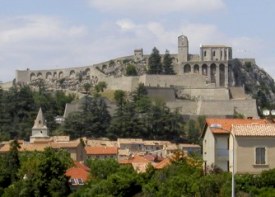Sisteron Citadelle
 Sisteron is a small town in the Alpes de Haute-Provence, half-way between Marseilles and Grenoble. Its unusual geographical location, on a river crossing between two very steep mountain ridges, has made it strategically important since earliest times. There are signs of Bronze-age settlement (ca. 2000 BC) by the Sogiontii tribe, from whom, by a long process of linguistic mangling, the name Sisteron comes.
Sisteron is a small town in the Alpes de Haute-Provence, half-way between Marseilles and Grenoble. Its unusual geographical location, on a river crossing between two very steep mountain ridges, has made it strategically important since earliest times. There are signs of Bronze-age settlement (ca. 2000 BC) by the Sogiontii tribe, from whom, by a long process of linguistic mangling, the name Sisteron comes.
The Romans incorporated Sisteron into the Via Domitia, the first Italy-Spain motorway, and Latin inscriptions can still be seen on rocks in the area (mostly, "Are we nearly there yet?") The Goths, Visigoths and Allans couldn't be bothered to overrun Sisteron, because it was miles from anywhere and much too hot, but the Saracens felt quite at home there in the seventh century. The first 'castle' i.e. solid fortification at Sisteron was begun in the eleventh century by the Counts of Forcalquier.
It's a superb location for a castle - a natural castle-sized rock, sitting between two mountains and towering 500m over the narrow river gorge below. In the fourteenth century, Sisteron became the northern outpost of the independent Domaine of Provence. In 1483, Provence and Sisteron finally joined the Kingdom of France, and probably wished they hadn't. They had barely recovered from an epidemic of seven plagues when the Wars of Religion began and Protestants and Catholics took it in turns to besiege each other in Sisteron for over a century. They also took it in turns to add to the castle fortifications, and it is these ramparts, on the crest of the castle rock, that you first see today as you motor up the A51.
In 1638, Jan Kazimierz Waza, Prince of Poland got bored of waiting to be King of Poland. A friend pointed out to Jan that he was already Viceroy of Portugal, and suggested he go there and be Viceroy for a while. Jan set off, looking forward to a little holiday in the sun, but as soon as he got to Sisteron he was arrested by the wicked Cardinal Richelieu. Richelieu quickly trumped up some charges along the lines of 'secret Polish-Spanish plot' and kept Jan for a year in a tiny, draughty cell at the top of the castle. Mind you, he had a lovely view. You can visit Jan's cell today, complete with a waxwork Jan and a seventeenth-century ensuite WC (a hole in the floor overhanging the ramparts.)
Sisteron's next starring role came in 1815. Napoleon had escaped from exile on the island of Elba, landed near Cannes, and started to march to Paris, collecting fans and soldiers as he went. Napoleon knew that politically-Royalist Sisteron would be a difficult gig, and approached the town with some trepidation. As it turned out, there was no armed opposition. Napoleon stayed for three hours, ate a splendid lunch in the town (as you can today,) and set off again with renewed vigour for, er, Waterloo.
The castle, or 'Citadelle' as it is known, is open every day from April to October, and by the time you've climbed up to the spectacular ramparts and down again, your legs will feel it.